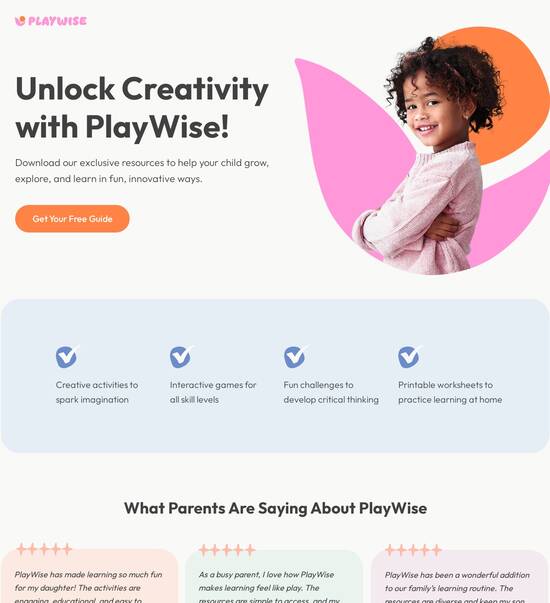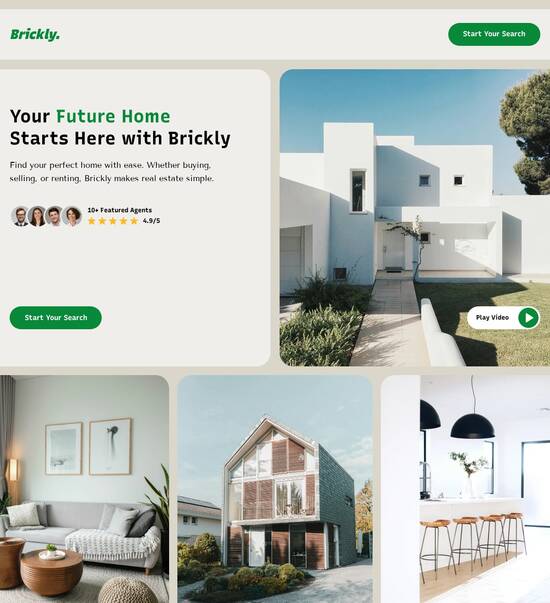
Landing page template with interactive expense report form
Explore Similar TemplatesAbout template
Use landing page templates with interactive expense report form and make your communications easy and transparent. Try our solution today.
Recommended templates

Easy to build without coding
With the intuitive drag-and-drop builder, anyone on your team can create high-converting pages without any knowledge of code or design. Make enhancements to your landing page with custom widgets using Javascript, HTML/CSS, or third-party scripts.

Multiple layouts for any industry and goal
Select from 500+ landing page layouts built to boost conversions across industry-specific scenarios. Customize them by adjusting fonts, adding images, and generating on-brand content with the AI assistant. Quickly scale with Instablocks® and Global Blocks that you can save, reuse, and update globally.

Loads fast and looks polished on any device
Every template is responsive, which means they present professionally on any device and load blazingly fast with our Thor Render Engine. You can also power them up with Google AMP technology to deliver an unparalleled mobile experience and drive higher conversions.

Robust analytics & experimentation
Get real-time updates and reporting across all your devices, showing the number of visitors, conversions, cost-per-visitor, and cost-per-lead. Launch AI-powered experiments, run A/B tests, and use heatmaps to analyze user behavior, then optimize your landing page to maximize conversions.







Easy to build without coding
With the intuitive drag-and-drop builder, anyone on your team can create high-converting pages without any knowledge of code or design. Make enhancements to your landing page with custom widgets using Javascript, HTML/CSS, or third-party scripts.
Multiple layouts for any industry and goal
Select from 500+ landing page layouts built to boost conversions across industry-specific scenarios. Customize them by adjusting fonts, adding images, and generating on-brand content with the AI assistant. Quickly scale with Instablocks® and Global Blocks that you can save, reuse, and update globally.
Loads fast and looks polished on any device
Every template is responsive, which means they present professionally on any device and load blazingly fast with our Thor Render Engine.
Robust analytics & experimentation
Get real-time updates and reporting across all your devices, showing the number of visitors, conversions, cost-per-visitor, and cost-per-lead. Launch AI-powered experiments, run A/B tests, and use heatmaps to analyze user behavior, then optimize your landing page to maximize conversions.
All the features you need to build lead-generating landing pages
Explore more featuresLearn how to build top-performing landing pages for any goal
FAQs
Leading the way in building high-performing landing pages





Landing page template with interactive expense report form
Utilizing a landing page template with an interactive expense report form can drastically improve data collection and user engagement. Instapage’s robust platform makes it easy to create high-converting pages tailored to your marketing strategies, ensuring that you maximize ROI. This guide will walk you through the steps to implement this powerful tool effectively.
Choosing the right landing page template
The first step in creating an effective landing page is selecting the right template. Instapage offers 100+ ready-to-use landing page templates, specifically designed for conversion. Consider templates that feature interactive forms or lead generation elements to engage users actively.
- High-converting design: Choose templates that have been tested for conversion rates.
- Mobile responsiveness: Ensure the template is adaptable across all devices to capture users on-the-go.
- Customization options: Look for templates that allow easy modifications to match your branding.
Creating the interactive expense report form
The next step involves designing the interactive expense report form. This form should be user-friendly and encourage completion. Utilize Instapage’s form builder, which allows for seamless integration of various input fields.
- Dynamic fields: Include input fields for expense categories to allow users to specify details easily.
- Validation: Ensure fields are validated for accuracy, such as numeric checks on costs.
- Submission confirmation: Set up automatic responses to users upon form submission, improving the experience.
Optimizing the landing page for conversions
After developing your landing page and form, optimization is key. Employing built-in experimentation features allows you to use heatmaps and analytics to assess user interactions dynamically.
- A/B testing: Run tests to compare elements like headlines and call-to-action buttons for better performance.
- Heatmaps: Analyze where users click the most to optimize form placements and page layouts.
- Targeted campaigns: Use personalized content suited to specific audience segments based on analytics.
By following these steps, you can create an effective landing page template with an interactive expense report form that not only meets user expectations but also drives conversions.
Take the first step towards transforming your marketing campaigns by leveraging Instapage’s innovative landing page solutions.
Explore the power of Instapage today and see how easy it can be to create landing pages that convert. Start your journey by signing up for our free trial!
People also ask about Landing page template with interactive expense report form
Landing page template with interactive expense report form
Understanding the significance of landing page templates in modern business environments
Landing pages are integral to digital marketing strategies, serving as focused gateways for potential customers. They are designed with a specific purpose in mind: to convert visitors into leads or customers by guiding them through a single, compelling call to action. Unlike a website homepage that provides vast information, landing pages present targeted messaging to drive specific visitor actions.
Moreover, landing pages optimize conversions by eliminating distractions and enhancing user experience. The combination of clear headlines, engaging visuals, and a direct message not only informs but also motivates users to act, whether that means signing up for a newsletter, requesting a demo, or filling out a form. This tailored approach is essential for successful online marketing campaigns.
The importance of interactive forms for user engagement
Interactive forms are crucial components of landing pages, significantly enhancing user engagement. When users interact with forms, they experience a sense of involvement, which can lead to increased satisfaction and higher conversion rates. Rather than passively consuming content, users actively participate, fostering a connection with the brand.
The impact of interactivity on conversion rates is profound. Studies show that forms integrating engaging elements, such as sliders or real-time calculations, can drastically reduce abandonment rates. Users are more likely to complete tasks that feel dynamic and responsive, ultimately leading to a successful interaction with the business.
Detailed overview of interactive expense report forms in landing pages
An interactive expense report form is a digital tool designed to facilitate the tracking and submission of business-related expenses. These forms are essential for maintaining financial oversight within companies while simplifying the process for employees. The core components of an expense report include fields for dates, categories of expenses, amounts, and descriptions, and they often feature options for attaching receipts.
For businesses, these forms not only streamline reporting but also provide a clear record of spending, which is vital for budgeting and financial planning. By having a centralized method for tracking expenses, businesses can easily review and analyze spending patterns to make informed financial decisions.
Features of interactive expense report forms
Interactive expense report forms come equipped with numerous features that enhance usability and functionality. These features typically include:
Expense type inputs
Fields to categorize different expenses such as travel, meals, supplies, and more.
File uploads for receipts
Allowing users to attach digital copies of receipts directly to their expense reports.
Real-time calculation
Automatically calculating the total expenses as users input their data to prevent errors.
User-friendly design
A layout that promotes easy navigation, making it simpler for users to fill out their reports.
The business impact of utilizing expense report templates
Using expense report templates can significantly streamline financial reporting processes within organizations. Automation of these processes reduces the burden on finance teams as manual data entry becomes a thing of the past. This not only saves time but also minimizes the risk of human error that often accompanies traditional methods of tracking expenses.
Additionally, the reduction in man-hours required for processing expenses means finance teams can redirect their focus toward strategic tasks, ultimately contributing to the overall efficiency of the organization. This shift leads to better resource allocation and enhanced financial insight, enabling management to make more informed decisions.
Customizable templates for specific needs
One of the prime advantages of using expense report templates is their customization capability. For example, a small business may require a simplified version of a report compared to larger enterprises that may need a more comprehensive approach. Customizable templates allow organizations to tailor their reports to their unique circumstances and operational requirements.
This flexibility in template design is crucial for different industries, as each may have particular regulations or spending categories that need to be monitored. By accommodating diverse needs, businesses can ensure that their expense reporting processes align perfectly with their operational workflows.
How interactive expense report forms enhance data collection
Interactive expense report forms are invaluable for enhancing data collection methodologies in organizations. They often include filtering mechanisms, which allow users to categorize expenses effectively. By organizing expenses into specific categories such as project budgets or departmental spending, companies gain insights that are critical for strategic planning.
Customized filters also enable control over data collection, allowing businesses to set limits based on spending thresholds or specific expense types. This rich dataset empowers financial analysts to produce comprehensive reports, benefiting decision-making processes at all levels of the organization.
Real-time feedback and reporting
Another valuable aspect of interactive forms is their capacity to provide real-time feedback regarding spending habits. Users can instantly see how much they've spent against their allowances, allowing for immediate adjustments. This proactive approach fosters financial responsibility among employees and ensures compliance with organizational budgets.
Additionally, generating reports for management review becomes a seamless process. With data collected in real-time, organizations can regularly assess spending patterns, highlight areas of concern, and adjust budgets accordingly. This proactive financial oversight is essential for sustained business success.
User-centric benefits of implementing interactive expense report forms
Implementing interactive expense report forms offers numerous user-centric benefits that directly enhance user engagement. The role of a growth marketing manager becomes pivotal here as they work towards improving interaction with these forms. Strategies such as simplifying layouts, providing clear calls to action, and including informative tooltips can help maintain user interest and encourage completion.
Moreover, simplifying reimbursement processes also plays a key role in improving employee satisfaction. Clear communication of policies and guidelines ensures users understand what is expected when filing for reimbursements. Punctual reimbursements not only help in maintaining a positive work environment but also increase overall productivity.
Step-by-step guide to setting up your interactive expense report form
Setting up an interactive expense report form can be a straightforward process if approached methodically. The first step involves choosing the right template that aligns with your organizational needs. Identifying core functionalities, essential fields, and user interface preferences will lead you to select the most suitable template.
Next, designing your interactive form using platforms like Instapage ensures seamless integration. Instapage offers robust tools for form creation that allows for efficient layout design. Combining best practices like intuitive navigation, compelling design, and clarity of purpose will enhance user experience.
Testing and launching the form
Once the form is designed, it’s crucial to undergo thorough testing to identify any potential issues. A/B testing can be particularly useful in determining which version of the form performs better, allowing for data-informed adjustments. Collecting user feedback post-launch is invaluable for continuous improvement, ensuring the form remains effective and user-friendly.
Case studies: success stories in the use of interactive expense reports
Small businesses implementing interactive expense report forms have seen remarkable improvements in their reporting processes. By embracing these templates, companies have significantly shortened the turnaround time for expense approvals. For instance, one marketing firm reported reducing submission and approval cycles from weeks to just days, resulting in improved cash flow.
Similarly, enterprise-level implementations have yielded benefits in comprehensive expense tracking across larger teams. Collaborative tools facilitate better communication between departments, helping to streamline reporting and ensure transparency. Case studies showcase businesses achieving greater alignment on budgets while enhancing accountability among teams, leading to increased organizational efficiency.
Future trends in expense reporting technology
Looking ahead, the integration of AI and automation into expense reporting technology is set to transform how organizations handle financial data. Predictive analytics has the potential to reshape budgeting processes, allowing for more accurate spend forecasting and strategic resource allocation. Businesses can harness AI to provide suggestions for categorizing expenses, enhancing accuracy and efficiency.
Moreover, integrating expense report forms with broader financial management systems enables a holistic view of organizational spending. Connected data facilitates real-time insights, allowing decision-makers to pivot strategies proactively. This seamless flow of information not only enhances operational efficiency but also supports comprehensive financial planning.
Best practices for businesses leveraging landing pages with interactive forms
To maximize the benefits of landing pages with interactive forms, businesses must adopt continuous optimization strategies. By tracking user behavior metrics, organizations can identify bottlenecks in data collection and adapt accordingly. Utilizing analytics tools to monitor completion rates and abandonment can drive improvements in form design.
Finally, exploring further customization opportunities is crucial for maintaining relevance as business needs evolve over time. Planning for scalability ensures that as a company grows, its processes remain efficient and effective. A well-designed interactive expense report form can adapt to these changing requirements, supporting long-term organizational success.
Ready to skyrocket conversions?
Supercharge your ad campaigns with high-performing landing pages
Get started














